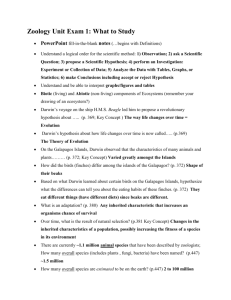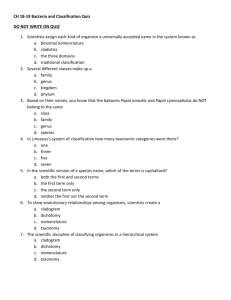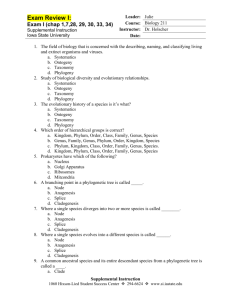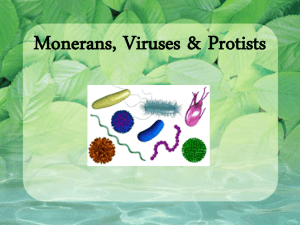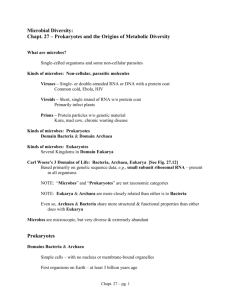1. What is not a characteristic of life? a. Reproduction b. Response
advertisement
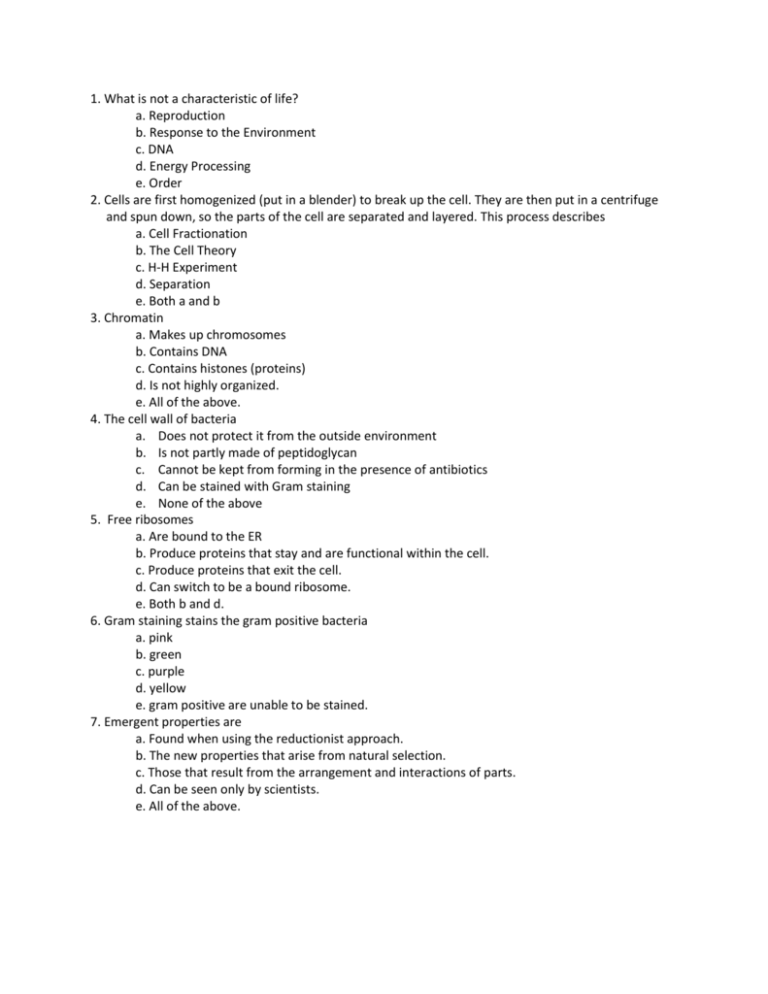
1. What is not a characteristic of life? a. Reproduction b. Response to the Environment c. DNA d. Energy Processing e. Order 2. Cells are first homogenized (put in a blender) to break up the cell. They are then put in a centrifuge and spun down, so the parts of the cell are separated and layered. This process describes a. Cell Fractionation b. The Cell Theory c. H-H Experiment d. Separation e. Both a and b 3. Chromatin a. Makes up chromosomes b. Contains DNA c. Contains histones (proteins) d. Is not highly organized. e. All of the above. 4. The cell wall of bacteria a. Does not protect it from the outside environment b. Is not partly made of peptidoglycan c. Cannot be kept from forming in the presence of antibiotics d. Can be stained with Gram staining e. None of the above 5. Free ribosomes a. Are bound to the ER b. Produce proteins that stay and are functional within the cell. c. Produce proteins that exit the cell. d. Can switch to be a bound ribosome. e. Both b and d. 6. Gram staining stains the gram positive bacteria a. pink b. green c. purple d. yellow e. gram positive are unable to be stained. 7. Emergent properties are a. Found when using the reductionist approach. b. The new properties that arise from natural selection. c. Those that result from the arrangement and interactions of parts. d. Can be seen only by scientists. e. All of the above. 8. The scientific name for movement is a. Busus b. Taxis c. Caras d. Planos e. Bicikletas 9. Where is a bacterial cell’s DNA found? a. Mitochondria b. Nucleus c. Peroxisome d. Nucleoid region e. Capsule 10. Which domains are most closely related to each other? a. Eukarya and Archaea b. Eukarya and Protista c. Bacteria and Eukarya d. Protista and Bacteria e. Protista and Archaea 11. Prokaryotic cells are found in the domain(s) _____. a. Bacteria and Archaea b. Bacteria and Eukarya c. Bacteria and Protista d. Bacteria e. Protista and Archaea 12. A plasmid is a. a small circular ring of DNA found in eukaryotes b. a small circular ring of DNA found in bacteria c. can be transferred through conjugation d. both a and c e. both b and c 13. _____ produces four daughter cells of a different ploidy, while _____ produces two identical daughter cells of the same ploidy. a. Mitosis, meiosis b. Mitosis, mitosis c. Meiosis, mitosis d. Meiosis, meiosis 14. Dinoflagellates, apicomplexans, and ciliates are placed in the clade Alveolata because they all a. have flagella or cilia. b. are parasites of animals. c. are found exclusively in freshwater or marine habitats. d. have mitochondria. e. have membrane-bounded sacs under their plasma membrane. 15. Which of these groups consist of parasitic flagellated cells, such as Trypanosoma, the organism that causes sleeping sickness? a. amoebozoans b. kinetoplastids c. diatoms d. green algae e. ciliates 16. Which of the following is present in a prokaryotic cell? a. mitochondrion b. ribosome c. nuclear envelope d. chloroplast e. ER 17. The bryophytes a. include mosses b. include liverworts c. are nonvascular d. include hornworts e. all of the above 18. Prokaryotes divide by a process called a. Meiosis b. Mitosis c. Binary Fission d. Cell Fractionation e. None of the Above 19. A theory is _____. a. a poorly supported idea that has little backing but might be correct. b. a well-supported concept that has broad explanatory power. c. the same thing as a hypothesis. d. not correct unless it is several years old. e. a concept that, once established in the scientific literature, can be modified but never rejected, even when new scientific methods produce data that don't fit. 20. In the life cycle of a fern, the multicellular male gametangium (the sex organ that produces sperm cells) is called a(n) _____. a. antheridium b. archegonium c. frond d. sporangium 21. Which of the following is not evidence that charophyceans are the closest algal relatives of plants? a. similar sperm structure b. apical meristems c. similarities in cell wall formation during cell division (phragmoplast) d. genetic similarities in chloroplasts e. similarities in proteins that synthesize cellulose 22. Which of the following is a correct sequence of levels in life’s hierarchy, proceeding downward from an individual animal? a. brain, organ system, nerve cell, nervous tissue b. organ system, nervous tissue, brain c. organism, organ system, tissue, cell, organ d. nervous system, brain, nervous tissue, nerve cell e. organ system, tissue, molecule, cell 23. The Endosymbiont Theory states a. That cells are genetic chimera b. That the similarities between mitochondria and prokaryotes is an important piece of evidence for this theory c. Eukaryotic cells evolved from prokaryotes that engulfed other prokaryotes d. Ancestors of eukaryotic cells formed a symbiotic relationship with prokaryotes e. All of the above 24. Taxonomy is ___. a. A hierarchical classification of organisms. b. A classification that reflects historical relationships. c. A division of organisms based on similar sets of characteristics d. Both a and c e. All of the above 25. What makes up the phospholipid bilayer? a. Proteins b. Phospholipids c. Ribosomes d. Both a and b. e. All of the above. 26.Resolution in science is a. Enlarging the image of an object. b. Turning a hypothesis into a theory. c. Amplifying the densities of objects. d. the smallest distance that two objects can be placed next to each other and still be distinguishable. e. None of the above. 27.. Protists and bacteria are grouped into different domains because a. protists eat bacteria. b. bacteria are not made of cells. c. protists have a membrane-bound nucleus, which bacterial cells lack. d. bacteria decompose protists. e. protists are photosynthetis. 28. Which protists have long, hairy flagella? a. alveolate b. euglenozoans c. amoebozoans d. stramenopiles e. radiolarians

